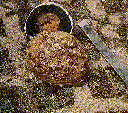
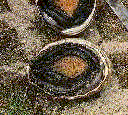
Red abalone shell Muscular foot
MS Word 97 version available
If you want to get an MS Word 97 version of this document, click here to download. The size is approximately 1.2 MB.
Table of contents:
Click on the hyperlinks below to see each section:
Is there a general population difference between the two coves?
Is there a general population difference at the depth intervals?
The objective of this experiment was to determine if the Red Abalone population in two coves along the Sonoma County coast was statistically significant. They were Stillwater Cove, a Sonoma County Regional Park and Gerstle Cove State Reserve, part of Salt Point State Park. Both are located about 70 miles NW of San Francisco.
The red abalone population has been steadily declining since the early 1990’s. Biologists, environmentalists and sport abalone divers want to preserve the abalone population. This has caused strong opposition from commercial abalone divers and the California Abalone Association, the industry trade group.
In the four years since I finished this experiment, the abalone population has sharply declined to perilously low levels, through a combination of high demand, over-harvesting, and poachers.
In May 1997, legislation was passed that will protect the existing abalone populations and ban commercial abalone harvesting from San Francisco to Mexico for 120 days.
An abalone is a sea mollusk that lives along the California coast. Their shells are shaped in the form of a spiral and have a lining of mother-of-pearl inside. Abalone are hunted for the meat, in reality the muscular foot, which is considered a delicacy. Their growth rate is approximately one inch per year. The price for abalone as of July 1997 is approximately $45-60 a pound.
The abalone studied in this experiment were Red Abalone, which are the most abundant species here. Other species of abalone are named in reference to the color of their shells. They include White, Green, Pink and Black.


Red abalone shell
Muscular foot
Click on the images to see a larger version. The piece of metal you see is called an "Abalone Iron", or "Ab Iron" for short. It's used to pry the abalone off the rocks.
Gerstle Cove State Reserve is a protected area within Salt Point State Park. Taking any sea life from it is prohibited. The maximum depth is approximately 55-60 feet. The wildlife in this area is as close to its natural state as possible, so it acts as a controlled environment.

This view looking S/SE shows one of the two yellow markers that
mark the boundary of the state reserve. The second marker is just
right to the center of the picture.
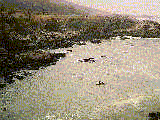
This view looking S/SW shows most of the state reserve region.
Stillwater Cove is part of the Sonoma County Regional Park system. Unlike Gerstle Cove, abalone hunting is permitted. The terrain is mostly sand and gradually changes to a rock formation landscape as you approach the ocean. The maximum depth is about 45 feet.
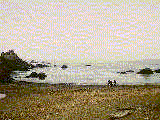
This is a view looking west from the beach.
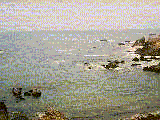
This picture looking NW from a cliff above Stillwater Cove gives a good overview of the area.
My goal was to collect about ten samples from each cove, using a depth range of 10-35 feet to determine if a general population difference existed between the two coves. Two samples would be taken from depth intervals located every 5 feet to determine if a general population difference exists at depth.
Due to adverse ocean conditions, I was only able to obtain five samples from each cove, one in each depth interval.
Non-parametric tests were used because there were too many factors that would prevent me from assuming that the abalone populations would be normally distributed. These included abalone movement, poaching, underwater conditions, and the fact I was collecting data during abalone season.
Two tests were performed in this experiment:
1) Wilcoxon Rank Sum Test for testing the general populations
2) Contingency tables for testing the depth intervals

H0 - The total number of abalone from Gerstle and
Stillwater coves are independent.
Ha - The total number of abalone from Gerstle and Stillwater
coves are dependent.
a = .10, 2-tailed test statistic (Reject H0 if T <= TL or T >= TU)
TL = 19, TU= 36, for n1 =
5, n2 = 5
(From Table 12, Appendix E in Statistics By Example, 4th Edition
by Sincich)
T = 17.5, reject H0 at a = .10, because T <= TL
Conclusion: The population distributions for Gerstle and Stillwater coves differ in location.

H0 - The number of abalone in each depth interval
is independent between the coves.
Ha - The number of abalone in each depth interval is
dependent between the coves.
c2 test statistic, using a =.10
c2= 4.9588; Reject H0 if c2 > c2(a = .10, 4 d.f.)
c2(a = .10, 4 d.f.) = 7.7794, don't reject H0 at a = .10
Conclusion: The number of abalone found in each depth interval is independent between the coves.
Although this experiment was a good first step in comparing abalone populations differences between protected and unprotected areas, it would have to be conducted over a period of at least one year to obtain sufficient long trend data.
Additionally, more locations along the coast would have to be selected for data sampling before any recommendations for restoring the abalone population can be made.
Currently, a combination of volunteer divers called SCAN (Sonoma County Abalone Network), aggressive law enforcement and prosecution of abalone poachers have been helping to preserve the abalone population. Abalone farms have also been active in helping to repopulate areas with low populations, however many farms have ceased operation.
I am optimistic that this very controversial issue will be resolved in the future. Local, county and state resources and agencies will have to work together to solve this problem effectively.
1) Tom Stienstra. "Wardens poach a big subject." San Francisco Examiner, June 8, 1997, Page C16.
2) Glen Martin. "Red abalone harvesting temporarily suspended, panel sets 4-month moratorium." San Francisco Chronicle, May 7, 1997, Page A17.
3) Alex Barnum. "Legislature to consider flood of coastal protection bills, effort called strongest in 25 years." San Francisco Chronicle, March 24, 1997, Page A17.
4) Alex Barnum. "Panel delays action on abalone harvest, biologists say commercial ban needed." San Francisco Chronicle, March 7, 1997, Page A28.
5) Tom Stienstra. "Abalone poachers caught, but the damage lingers on." San Francisco Examiner, Dec. 8, 1996, Page A1.
6) Tom Stienstra. "Nothing phony about efforts to save abalone." San Francisco Examiner, Dec. 1, 1996, Page D14.
7) George Snyder. "12th verdict in abalone poaching case." San Francisco Chronicle, May 30, 1996, Page C3.
8) George Snyder. "On alert for abalone poachers, volunteer divers guard North Coast." San Francisco Chronicle, May 14, 1996, Page A13.
9) Eve Mitchell. "Ocean farms aim for steady supply of once-declining delicacy." San Francisco Examiner, October 30, 1995, Page D1.
For general information about abalone regulations in California:
State of California
Department of Fish and Game
1416 Ninth Street
Sacramento, CA 95814
http://www.dfg.ca.gov
For detailed information about abalone and marine aquaculture:
State of California
Department of Fish and Game
Marine Resources Division
http://www.dfg.ca.gov/mrd/abindex0.html
Seafood Network Information Center (Seafood NIC)
University of California, Davis
Davis, CA 95616
http://www-seafood.ucdavis.edu/pubs/abalone.htm
Bodega Marine Laboratory
2099 Westside Road
Bodega Bay, CA 94923
http://www-bml.ucdavis.edu
For information about abalone farming:
FishTech, Inc.
1750 Montgomery Street
San Francisco, CA 94111
http://www.fishtech.com
According to a two-year study in 1974-1975 by the California Department of Fish and game, identified six major reasons for the decline in the abalone populations along the California coast:
1) Predation from sea otters (a major predator) that expanded their range in central California.
2) Mortality rate of sublegal sized abalone. A major cause is by bleeding to death when the muscular foot is sliced by an abalone iron during a harvesting attempt.
3) Over-harvesting by divers. Abalone populations are easily depleted because of slow growth and variable reproduction success.
4) Competition with other animals, like sea urchins. When the sea urchin population grows, they effectively push the abalone out by utilizing their feeding and living space.
5) Poaching by divers who intentionally ignore abalone regulations.
6) Loss of habitat caused by coastal development and pollution.
These are the actual diving conditions that are expected along the Sonoma County Coast.
They are not exaggerations!